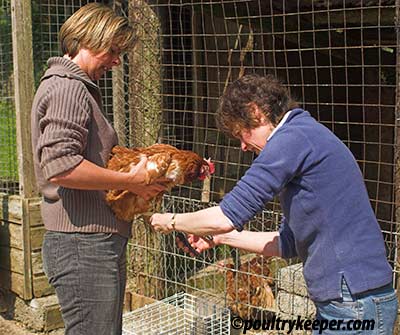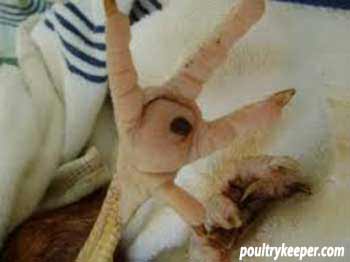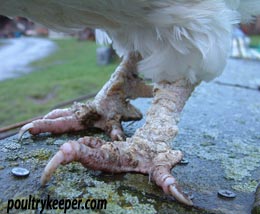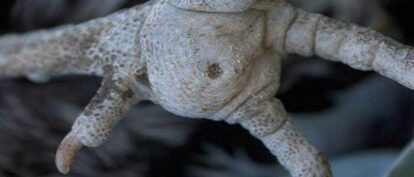Lameness and leg problems can occasionally occur in poultry, and there are various reasons these can occur.
Start by catching the bird as quickly and calmly as possible. A catching net can really help in large areas, but you can use the corner of a run to catch a bird quickly, especially if there are two people to do this.
Examine the legs and feet to establish whether there has been any injury due to an accident that has caused damage to a birds legs. Look for cuts and/or bleeding. Open wounds need similar treatment to cuts we might sustain. Bleeding needs to be stopped by applying a sterile bandage or dressing, and larger cuts may need antibiotics prescribed by your vet to combat bacterial infection (see Cuts and Wounds for further advice). However, the legs have restricted blood flow, so they don’t usually bleed severely.
Nails
Inspect nails, ensuring they aren’t too long, causing discomfort.
Nails usually aren’t ever a problem for free-range chickens as they are worn down naturally. Battery Chickens usually require their nails trimming when they come out of the cage. You can do this with dog nail clippers; make sure you don’t cut them too far back where there is a blood vessel. Trimming a little at a time is normally the safest.

Bumblefoot
If there are no obvious injuries to the legs, examine the bottom of the foot. A cut on the pad/bottom of the foot can cause Staphylococcus bacteria to infect the foot and the pad to swell, causing lameness. This swollen pad is normally called Bumblefoot. When squeezed, there can be puss coming out of it.
Bumblefoot is thought to be caused by some things:
A heavy landing from high perches (low perches are better for heavy breeds such as Orpingtons, Wyandottes or Jersey Giants) or rough perches but basically anything that can cause a splinter in the foot can cause Bumblefoot, so make sure there are no sharp splinters anywhere that are likely to cause problems for your chickens.

Swollen legs/feet
In ducks and geese, staphylococcus infection can occur in the leg and foot. This results in a swelling that feels hot to the touch and causes the bird to limp, hold its leg or go off its feet.
Staphylococcus infection occurs in the tendon sheaths, so it can take a long time to heal (tendons have very little blood supply). It seems to affect young geese more than adults.
To prevent this, ensure birds have clean, short grass to graze and there are no sharp objects or gaps where a leg could be trapped and cause a cut or sprain. Supply a pelleted feed to make sure birds are well fed and are receiving sufficient vitamins and minerals.
If a bird is limping, restrict the use of the leg by restricting the area it has available and try to provide clean water deep enough for swimming that is easy to get in and out of to help the recovery process. Cooling the leg down repeatedly can help tendons to recover.
Wounds can get infected and may require an antibiotic injection from your vet. This is better administered sooner rather than later. Vets will usually use Amoxicillin, a broad-spectrum antibiotic.
Mycoplasma Synoviae
Working up from the feet, legs and hock joint should be examined. If they feel hot and look swollen and/or are painful to touch, it could be caused by Mycoplasma synoviae, which can sometimes be serious. It is best to visit your vet so that they may examine the bird and provide a course of antibiotics (often Tylan) if appropriate.
Scaly leg mite
Scales on the legs should be smooth. If scales are raised, this can be due to a burrowing mite (Knemidocoptes mutans) or better known as Scaly Leg Mite. You should not pick these off; however, they look.
A treatment of dipping the cleaned legs into surgical spirits weekly for a month is usually recommended by vets to kill the mites, followed by covering the legs with Vaseline, which will soften the scales and suffocate the mites in between surgical spirit treatments.
It will take many months before the scales drop off and are regrown. Scales are replaced, just like feathers, but you must wait for this to happen naturally and not pull scales off.

Ivermectin drops can also be used to kill scaly leg mites and are often seen as an easy to use solution. Still, these are not licensed for use on food-producing animals such as chickens, so they should, therefore, only be used when prescribed by your vet, who will also advise a suitable withdrawal period for your eggs.
Worms
Worms can cause poultry (especially waterfowl) to go off their feet, although it isn’t that common for this to happen.
Geese pick up worms more often than ducks, especially if their pasture is well used. Routine worming with Flubenvet should prevent this from being a problem.
See Worming Ducks for further information.

Other potential problems
Pasteurella (Fowl cholera) can cause waterfowl to go off their feet. This is normally identified by green droppings, lack of appetite and increased thirst. A bacterial infection causes it, so a short course can normally clear it of antibiotics like Tylan, prescribed by your vet.


